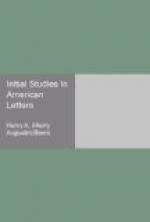Charles Brockden Brown, the first American novelist of any note, was also the first professional man of letters in this country who supported himself entirely by his pen. He was born in Philadelphia in 1771, lived a part of his life in New York and part in his native city, where he started, in 1803, the Literary Magazine and American Register. During the years 1798-1801 he published in rapid succession six romances, Wieland, Ormond, Arthur Mervyn, Edgar Huntley, Clara Howard, and Jane Talbot. Brown was an invalid and something of a recluse, with a relish for the ghastly in incident and the morbid in character. He was in some points a prophecy of Poe and Hawthorne, though his art was greatly inferior to Poe’s, and almost infinitely so to Hawthorne’s. His books belong more properly to the contemporary school of fiction in England which preceded the “Waverley Novels”—to the class that includes Beckford’s Vathek, Godwin’s Caleb Williams and St. Leon, Mrs. Shelley’s Frankenstein, and such “Gothic” romances as Lewis’s Monk, Walpole’s Castle of Otranto, and Mrs. Radcliffe’s Mysteries of Udolpho. A distinguishing characteristic of this whole school is what we may call the clumsy-horrible. Brown’s romances are not wanting in inventive power, in occasional situations that are intensely thrilling, and in subtle analysis of character; but they are fatally defective in art. The narrative is by turns abrupt and tiresomely prolix, proceeding not so much by dialogue as by elaborate dissection and discussion of motives and states of mind, interspersed with the author’s reflections. The wild improbabilities of plot and the unnatural and even monstrous developments of character are in startling contrast with the old-fashioned preciseness of the language; the conversations, when there are any, being conducted in that insipid dialect in which a fine woman was called an “elegant female.” The following is a sample description of one of Brown’s heroines, and is taken from his novel of Ormond, the leading character in which—a combination of unearthly intellect with fiendish wickedness—is thought to have been suggested by Aaron Burr: “Helena Cleves was endowed with every feminine and fascinating quality. Her features were modified by the most transient sentiments and were the seat of a softness at all times blushful and bewitching. All those graces of symmetry, smoothness, and luster, which assemble in the imagination of the painter when he calls from the bosom of her natal deep the Paphian divinity, blended their perfections in the shade, complexion, and hair of this lady.” But, alas! “Helena’s intellectual deficiencies could not be concealed. She was proficient in the elements of no science. The doctrine of lines and surfaces was as disproportionate with her intellects as with those of the mock-bird. She had not reasoned on the principles of human action, nor examined the structure of society. . . . She could not commune in their native dialect with the sages of Rome and Athens. . . . The constitution of nature, the attributes of its Author, the arrangement of the parts of the external universe, and the substance, modes of operation, and ultimate destiny of human intelligence were enigmas unsolved and insoluble by her.”




